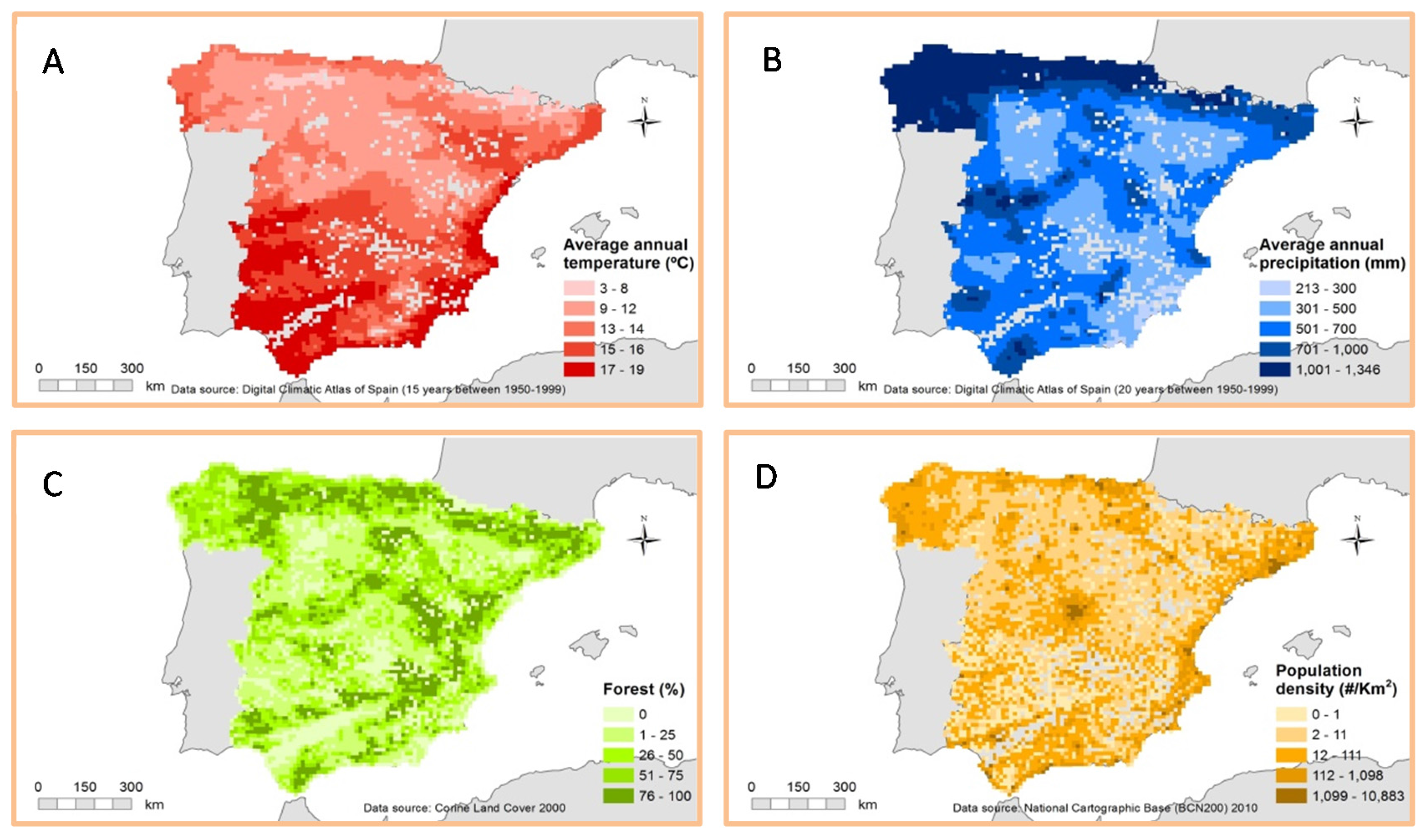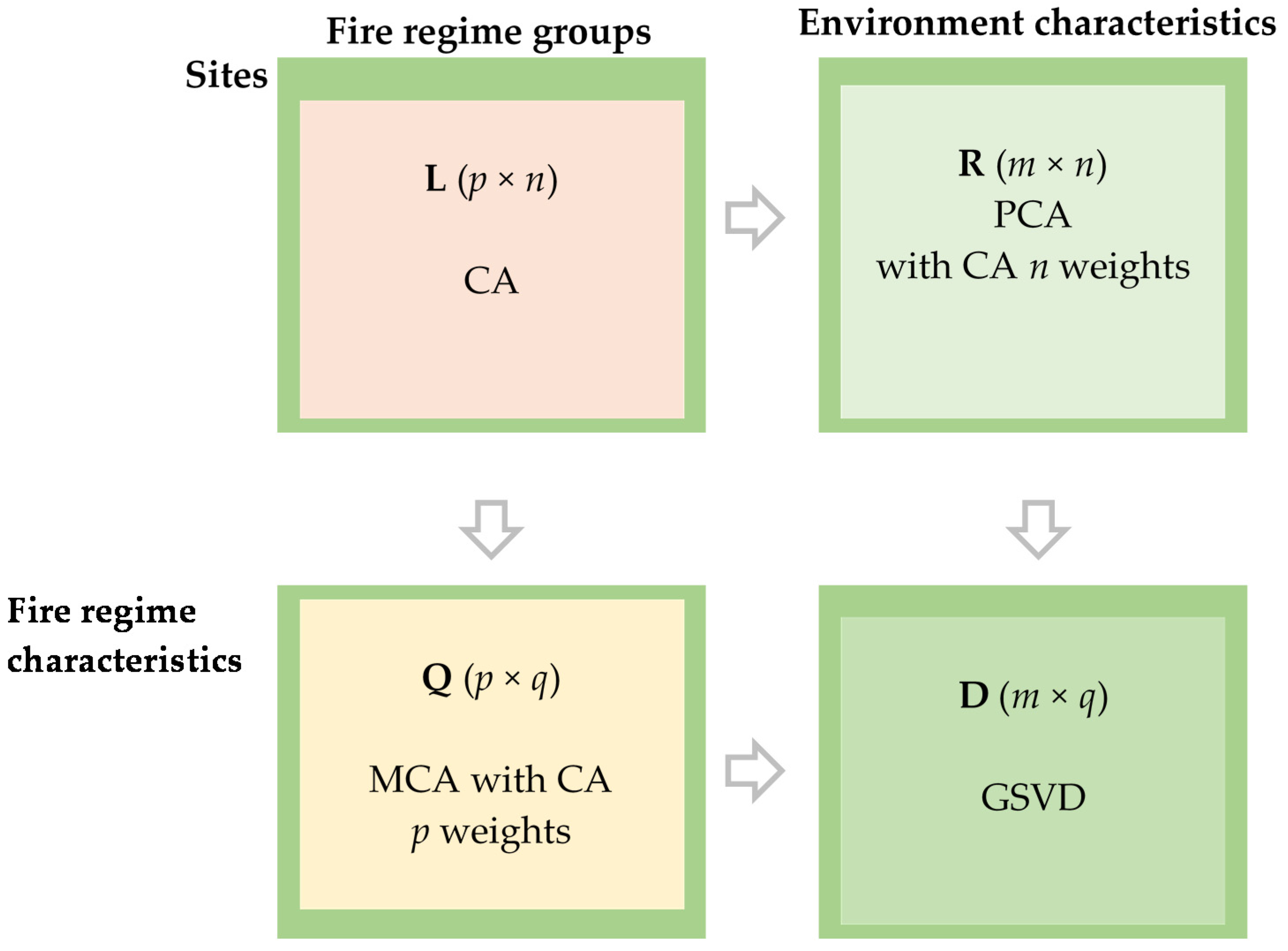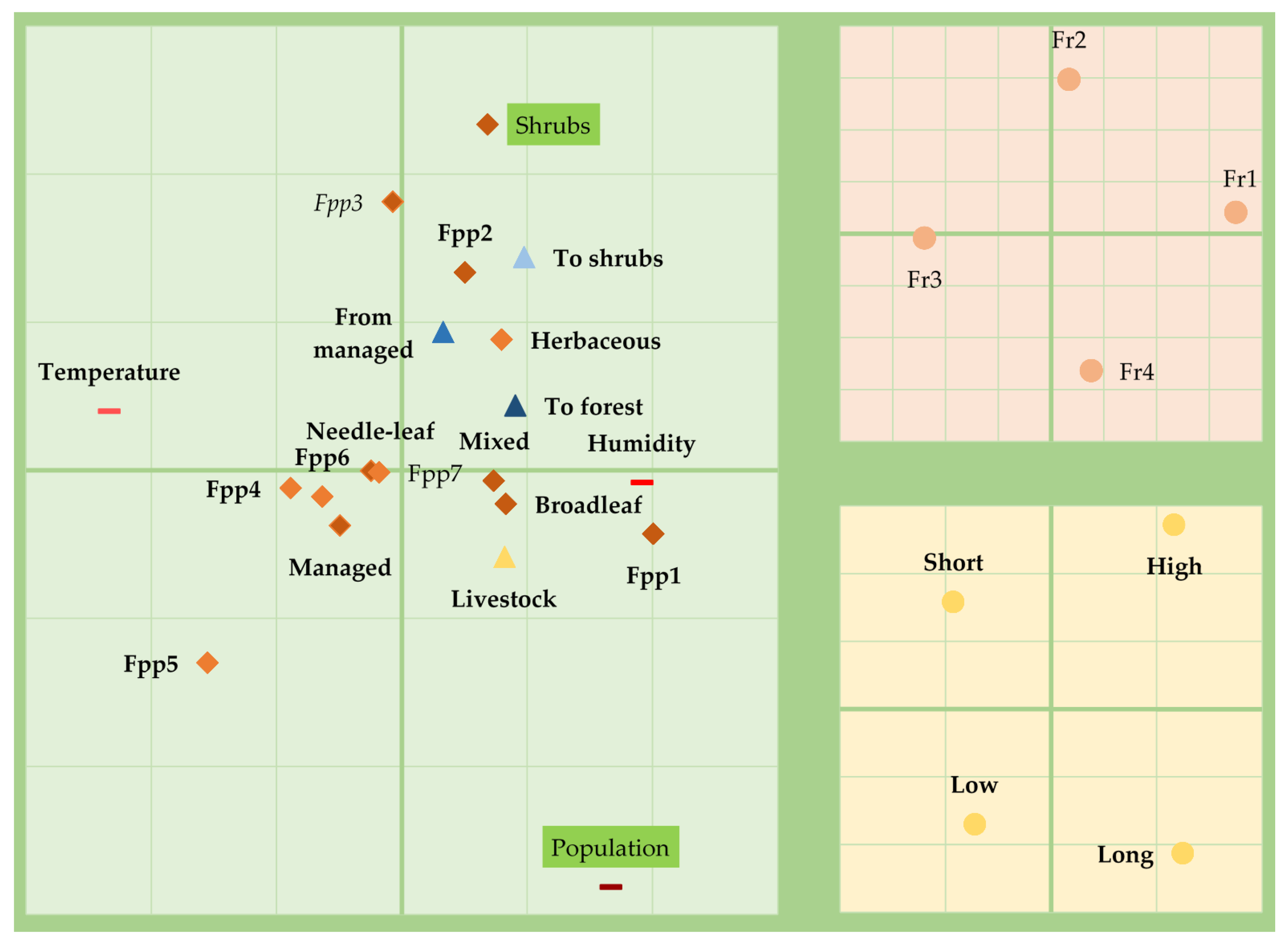Fire Regime Characteristics along Environmental Gradients in Spain
Abstract
:1. Introduction
2. Materials and Methods
2.1. Study Area
2.2. Fire Regime Groups and Fire Regime Characteristics
2.3. Environmental Gradients
2.4. RLQ Analysis
2.5. Fourth-Corner Analysis
2.6. Combining RLQ and Fourth-CornerAnalyses
3. Results
3.1. Global Multivariate Statistic
3.2. Decomposition of Inertia
3.3. Fire Regime Characteristics-Environmental Structures and Relationships
4. Discussion
5. Conclusions
Acknowledgments
Author Contributions
Conflicts of Interest
Abbreviations
| UTM | Universal Transverse Mercator |
| PCA | Principal Component Analysis |
| BCN200 | National Cartography Base |
| ED50 | European Datum 1950 |
| CA | Correspondence Analysis |
| MCA | Multiple Correspondence Analysis |
| FPP | Forest Potential Productivity |
References
- Bowman, D.M.J.S.; Balch, J.K.; Artaxo, P.; Bond, W.J.; Carlson, J.M.; Cochrane, M.A.; D’Antonio, C.M.; DeFries, R.S.; Doyle, J.C.; Harrison, S.P.; et al. Fire in the earth system. Science 2009, 324, 481–484. [Google Scholar] [CrossRef] [PubMed]
- Bond, W.J.; Keeley, J.E. Fire as a global “herbivore”: The ecology and evolution of flammable ecosystems. Trends Ecol. Evol. 2005, 20, 387–394. [Google Scholar] [CrossRef] [PubMed]
- Gill, A.M. Fire and the Australian flora: A review. Aust. For. 1975, 38, 4–25. [Google Scholar] [CrossRef]
- Westerling, A.L.; Hidalgo, H.G.; Cayan, D.R.; Swetnam, T.W. Warming and earlier spring increase western U.S. Forest wildfire activity. Science 2006, 313, 940–943. [Google Scholar] [CrossRef] [PubMed]
- Le Page, Y.; Oom, D.; Silva, J.M.N.; Jönsson, P.; Pereira, J.M.C. Seasonality of vegetation fires as modified by human action: Observing the deviation from eco-climatic fire regimes. Glob. Ecol. Biogeogr. 2010, 19, 575–588. [Google Scholar] [CrossRef]
- Magi, B.I.; Rabin, S.; Shevliakova, E.; Pacala, S. Separating agricultural and non-agricultural fire seasonality at regional scales. Biogeosciences 2012, 9, 3003–3012. [Google Scholar] [CrossRef] [Green Version]
- Archibald, S.; Staver, A.C.; Levin, S.A. Evolution of human-driven fire regimes in Africa. Proc. Natl. Acad. Sci. USA 2011, 109, 847–852. [Google Scholar] [CrossRef] [PubMed]
- Bowman, D.M.J.S.; Balch, J.; Artaxo, P.; Bond, W.J.; Cochrane, M.A.; D’Antonio, C.M.D.; DeFries, R.; Johnston, F.H.; Keeley, J.E.; Krawchuk, M.A.; et al. The human dimension of fire regimes on earth. J. Biogeogr. 2011, 38, 2223–2236. [Google Scholar] [CrossRef] [PubMed]
- Cochrane, M.A.; Alenca, A.; Schulze, M.D.; Souza, C.M.; Nepstad, D.C.; Lefebvre, P.; Davidson, E.A. Positive feedbacks in the fire dynamic of closed canopy tropical forests. Science 1999, 284, 1832–1835. [Google Scholar] [CrossRef] [PubMed]
- Mollicone, D.; Eva, H.D.; Achard, F. Ecology: Human role in Russian wild fires. Nature 2006, 440, 436–437. [Google Scholar] [CrossRef] [PubMed]
- Martell, D.L.; Sun, H. The impact of fire suppression, vegetation, and weather on the area burned by lightning-caused forest fires in Ontario. Can. J. For. Res. 2008, 38, 1547–1563. [Google Scholar] [CrossRef]
- Pechony, O.; Shindell, D. Driving forces of global wildfires over the past millennium and the forthcoming century. Proc. Natl. Acad. Sci. USA 2010, 107, 19167–19170. [Google Scholar] [CrossRef] [PubMed]
- Krawchuk, M.A.; Moritz, M.A.; Parisien, M.-A.; van Dorn, J.; Hayhoe, K. Global pyrogeography: The current and future distribution of wildfire. PLoS ONE 2009, 4, e5102. [Google Scholar] [CrossRef] [PubMed]
- Vannière, B.; Colombaroli, D.; Chapron, E.; Leroux, A.; Tinner, W.; Magny, M. Climate versus human-driven fire regimes in Mediterranean landscapes: The Holocene record of Lago dell’Accesa (Tuscany, Italy). Quat. Sci. Rev. 2008, 27, 1181–1196. [Google Scholar] [CrossRef] [Green Version]
- Chuvieco, E. Global impacts of fire. In Earth Observation of Wildland Fires in Mediterrranean Ecosystems; Chuvieco, E., Ed.; Springer: Berlin, Germany, 2009; Volume 2, p. 257. [Google Scholar]
- Harrison, S.P.; Marlon, J.R.; Bartlein, P.J. Fire in the earth system. In Changing Climates, Earth Systems and Society; Dodson, J., Ed.; Springer: Dordrecht, The Netherlands, 2010; pp. 21–48. [Google Scholar]
- O’Connor, C.D.; Garfin, G.M.; Falk, D.A.; Swetnam, T.W. Human pyrogeography: A new synergy of fire, climate and people is reshaping ecosystems across the globe. Geogr. Compass 2011, 5, 329–350. [Google Scholar] [CrossRef]
- Moritz, M.A.; Morais, M.E.; Summerell, L.A.; Carlson, J.M.; Doyle, J. Wildfires, complexity, and highly optimized tolerance. Proc. Natl. Acad. Sci. USA 2005, 102, 17912–17917. [Google Scholar] [CrossRef] [PubMed]
- Parisien, M.-A.; Moritz, M.A. Environmental controls on the distribution of wildfire at multiple spatial scales. Ecol. Monogr. 2009, 79, 127–154. [Google Scholar] [CrossRef]
- Archibald, S. Managing the human component of fire regimes: Lessons from Africa. Phil. Trans. R. Soc. B 2016, 371, 20150346. [Google Scholar] [CrossRef] [PubMed]
- Krawchuk, M.A.; Moritz, M.A. Constraints on global fire activity vary across a resource gradient. Ecology 2011, 92, 121–132. [Google Scholar] [CrossRef] [PubMed]
- Meyn, A.; White, P.S.; Buhk, C.; Jentsch, A. Environmental drivers of large, infrequent wildfires: The emerging conceptual model. Prog. Phys. Geogr. 2007, 31, 287–312. [Google Scholar] [CrossRef]
- Batllori, E.; Parisien, M.-A.; Krawchuk, M.A.; Moritz, M.A. Climate change-induced shifts in fire for Mediterranean ecosystems. Glob. Ecol. Biogeogr. 2013, 22, 1118–1129. [Google Scholar] [CrossRef]
- Pausas, J.G.; Bradstock, R.A. Fire persistence traits of plants along a productivity and disturbance gradient in Mediterranean shrublands of south-east Australia. Glob. Ecol. Biogeogr. 2007, 16, 330–340. [Google Scholar] [CrossRef]
- Pausas, J.G.; Ribeiro, E. The global fire-productivity relationship. Glob. Ecol. Biogeogr. 2013, 22, 728–736. [Google Scholar] [CrossRef]
- Chuvieco, E.; Giglio, L.; Justice, C. Global characterization of fire activity: Toward defining fire regimes from earth observation data. Glob. Chang. Biol. 2008, 14, 1488–1502. [Google Scholar] [CrossRef]
- Archibald, S.; Lehmann, C.E.R.; Gómez-Dans, J.L.; Bradstock, R.A. Defining pyromes and global syndromes of fire regimes. Proc. Natl. Acad. Sci. USA 2013, 110, 6442–6447. [Google Scholar] [CrossRef] [PubMed]
- Pausas, J.G.; Paula, S. Fuel shapes the fire-climate relationship: Evidence from Mediterranean ecosystems. Glob. Ecol. Biogeogr. 2012, 21, 1074–1082. [Google Scholar] [CrossRef]
- Pausas, J.G.; Fernández-Muñoz, S. Fire regime changes in the western Mediterranean Basin: From fuel-limited to drought-driven fire regime. Clim. Chang. 2012, 110, 215–226. [Google Scholar] [CrossRef] [Green Version]
- Moreno, M.V.; Conedera, M.; Chuvieco, E.; Pezzatti, G.B. Fire regime changes and major driving forces in Spain from 1968 to 2010. Environ. Sci. Policy 2014, 37, 11–22. [Google Scholar] [CrossRef]
- Ninyerola, M.; Pons, X.; Roure, J. Atlas Climático Digital de la Península Ibérica. Metodología y Aplicaciones en Bioclimatología y Geobotánica; Universitat Autònoma de Barcelona: Bellaterra, Spain, 2005. [Google Scholar]
- Moreno, M.V.; Chuvieco, E. Characterising fire regimes in Spain from fire statistics. Int. J. Wildland Fire 2013, 22, 296–305. [Google Scholar] [CrossRef]
- Moreira, F.; Rego, F.C.; Ferreira, P.G. Temporal (1958–1995) pattern of change in a cultural landscape of northwestern Portugal: Implications for fire occurrence. Landsc. Ecol. 2001, 16, 557–567. [Google Scholar] [CrossRef]
- Martínez, J.; Vega-García, C.; Chuvieco, E. Human-caused wildfire risk rating for prevention planning in Spain. J. Environ. Manag. 2009, 90, 1241–1252. [Google Scholar] [CrossRef] [PubMed]
- Kohnke, H.; Stuff, R.G.; Miller, P.A. Quantitative relations between climate and soil formation. Z. Pflanzenernähr. Bodenkd. 1968, 119, 24–33. [Google Scholar] [CrossRef]
- Sánchez Palomares, O.; Sánchez Serrano, F. Mapa de la Productividad Potencial Forestal de España; Ministerio de Agricultura, Alimentación y Medio Ambiente: Madrid, Spain, 2000.
- Herold, M.; Mayaux, P.; Woodcock, C.E.; Baccini, A.; Schmullius, C. Some challenges in global land cover mapping: An assessment of agreement and accuracy in existing 1 km datasets. Remote Sens. Environ. 2008, 112, 2538–2556. [Google Scholar] [CrossRef]
- Moreno, M.V.; Chuvieco, E. Validation of global land cover products for the Spanish peninsular area. Rev. Teledetec. 2009, 31, 5–22. [Google Scholar]
- Dolédec, S.; Chessel, D.; Braak, C.J.F.; Champely, S. Matching species traits to environmental variables: A new three-table ordination method. Environ. Ecol. Stat. 1996, 3, 143–166. [Google Scholar] [CrossRef]
- Legendre, P.; Legendre, L. Ordination in reduced space. In Developments in Environmental Modelling; Pierre, L., Louis, L., Eds.; Elsevier: Amsterdam, The Netherlands, 1998; Volume 20, Chapter 9; pp. 387–480. [Google Scholar]
- Legendre, P.; Galzin, R.; Harmelin-Vivien, M.L. Relating behavior to habitat: Solutions to the fourth-corner problem. Ecology 1997, 78, 547–562. [Google Scholar] [CrossRef]
- Benjamini, Y.; Hochberg, Y. Controlling the false discovery rate: A practical and powerful approach to multiple testing. J. R. Stat. Soc. Ser. B 1995, 57, 289–300. [Google Scholar]
- Dray, S.; Legendre, P. Testing the species traits-environment relationships: The fourth-corner problem revisited. Ecology 2008, 89, 3400–3412. [Google Scholar] [CrossRef] [PubMed]
- Ter Braak, C.J.F.; Cormont, A.; Dray, S. Improved testing of species traits—Environment relationships in the fourth-corner problem. Ecology 2012, 93, 1525–1526. [Google Scholar] [CrossRef] [PubMed]
- Dray, S.; Choler, P.; Dolédec, S.; Peres-Neto, P.R.; Thuiller, W.; Pavoine, S.; ter Braak, C.J.F. Combining the fourth-corner and the RLQ methods for assessing trait responses to environmental variation. Ecology 2013, 95, 14–21. [Google Scholar] [CrossRef]
- Dray, S.; Dufour, A.-B. The ade4 package: Implementing the duality diagram for ecologists. J. Stat. Softw. 2007, 22, 1–20. [Google Scholar] [CrossRef]
- Vélez, R. Incenidos forestales y su relacion con el medio rural. Rev. Estud. Agrosoc. 1986, 136, 195–224. [Google Scholar]
- Pausas, J.G. Change in fire and climate in the eastern Iberian Peninsula (Mediterranea Basin). Clim. Chang. 2004, 63, 337–350. [Google Scholar] [CrossRef]
- Viegas, D.; Viegas, M. A relationship between rainfall and burned area for Portugal. Int. J.Wildland Fire 1994, 4, 11–16. [Google Scholar] [CrossRef]
- Pereira, M.G.; Trigo, R.M.; da Camara, C.C. Synoptic patterns associated with large summer forest fires in Portugal. Agric. For. Meteorol. 2005, 129, 11–25. [Google Scholar] [CrossRef]
- Lloret, F.; Marí, G. A comparison of the medieval and the current fire regimes in managed pine forests of Catalonia (NE Spain). For. Ecol. Manag. 2001, 141, 155–163. [Google Scholar] [CrossRef]
- Syphard, A.D.; Radeloff, V.C.; Keeley, J.E.; Hawbaker, T.J.; Clayton, M.K.; Stewart, S.I.; Hammer, R.B. Human influence on California fire regimes. Ecol. Appl. 2007, 17, 1388–1402. [Google Scholar] [CrossRef] [PubMed]
- Vázquez de la Cueva, A.; García del Barrio, J.M.; Ortega, M.; Sánchez, O. Recent fire regimes in peninsular Spain in relation to forest potential productivity and population density. Int. J. Wildland Fire 2006, 15, 397–405. [Google Scholar] [CrossRef]
- Pezzatti, G.B.; Zumbrunnen, T.; Bürgi, M.; Ambrosetti, P.; Conedera, M. Fire regime shifts as a consequence of fire polity and socio-economic development: An analysis based on the change point approach. For. Policy Econ. 2013, 29, 7–18. [Google Scholar] [CrossRef]
- Archibald, S.; Roy, D.P.; Brian, W.; Wilgen, V.; Scholes, R.J. What limits fire? An examination of drivers of burn area in southern Africa. Glob. Chang. Biol. 2009, 15, 613–630. [Google Scholar] [CrossRef]
- Vázquez, A.; Moreno, J.M. Spatial distribution of forest fires in Sierra de Gredos (central Spain). For. Ecol. Manag. 2001, 147, 55–65. [Google Scholar] [CrossRef]



| Fire Regime Groups | Number of 10 km × 10 km Cells | Fire Regime Characteristics | |
|---|---|---|---|
| Fire regime 1 | 703 | High density | Long seasonality |
| Fire regime 2 | 1083 | High density | Short seasonality |
| Fire regime 3 | 1582 | Low density | Short seasonality |
| Fire regime 4 | 1284 | Low density | Long seasonality |
| Environmental Gradients | Environmental Characteristics | Data Source | |
|---|---|---|---|
| Direct gradients | Climate | Humidity | Digital Climatic Atlas of Spain [31] (20 and 15 years between 1950–1999 respectively) |
| Seasonal temperature fluctuation | |||
| Human | Population density | National Cartographic Base (BCN200; 2010), National Geographic Institute | |
| Resource gradients | Forest potential productivity | Forest potential productivity 1 | Forest Potential Productivity map of Spain, 2000 [36] |
| Forest potential productivity 2 | |||
| Forest potential productivity 3 | |||
| Forest potential productivity 4 | |||
| Forest potential productivity 5 | |||
| Forest potential productivity 6 | |||
| Forest potential productivity 7 | |||
| Land cover | Needle-leaf trees | Corine Land Cover 2000 map, National Geographic Institute | |
| Broadleaf trees | |||
| Mixed trees | |||
| Shrubs | |||
| Herbaceous vegetation | |||
| Cultivated and managed vegetation/agriculture (including mixtures) | |||
| Indirect gradients | Livestock grazing | Livestock density | Rural census 2001, National Statistics Institute |
| Land cover changes | To forest | Corine Land Cover Change 1990–2000 map, National Geographic Institute | |
| To shrubs | |||
| From managed | |||
| Fire Regime Characteristics-Environment (RLQ Axes) | eig | covar | sdR | sdQ | corr |
| First RQL axis | 0.45 (96%) | 0.67 | 1.88 | 0.69 | 0.52 |
| Second RLQ axis | 0.02 (4%) | 0.14 | 1.51 | 0.73 | 0.13 |
| Environmental characteristics (Matrix R) | inertia | max | ratio | ||
| First RLQ axis | 3.54 | 4.10 | 0.87 | ||
| First and second RLQ axes | 5.84 | 6.78 | 0.86 | ||
| Fire regime characteristics (Matrix Q) | inertia | max | ratio | ||
| First RLQ axis | 0.47 | 0.53 | 0.90 | ||
| First and second RLQ axes | 1.00 | 1.00 | 1.00 | ||
| Fire regime groups (Matrix L) | corr | max | ratio | ||
| First RLQ axis | 0.52 | 1.00 | 0.52 | ||
| Second RLQ axis | 0.13 | 1.00 | 0.13 |
© 2016 by the authors; licensee MDPI, Basel, Switzerland. This article is an open access article distributed under the terms and conditions of the Creative Commons Attribution (CC-BY) license (http://creativecommons.org/licenses/by/4.0/).
Share and Cite
Moreno, M.V.; Chuvieco, E. Fire Regime Characteristics along Environmental Gradients in Spain. Forests 2016, 7, 262. https://doi.org/10.3390/f7110262
Moreno MV, Chuvieco E. Fire Regime Characteristics along Environmental Gradients in Spain. Forests. 2016; 7(11):262. https://doi.org/10.3390/f7110262
Chicago/Turabian StyleMoreno, María Vanesa, and Emilio Chuvieco. 2016. "Fire Regime Characteristics along Environmental Gradients in Spain" Forests 7, no. 11: 262. https://doi.org/10.3390/f7110262







